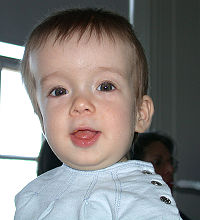
Photo from wikipedia
Heterozygous loss‐of‐function mutations of FGFR1 (fibroblast growth factor receptor 1) cause various disorders including hypogonadotropic hypogonadism with split‐hand/foot malformation (HH‐SHFM). We examined FGFR1 in four Japanese patients with HH‐SHFM (cases… Click to show full abstract
Heterozygous loss‐of‐function mutations of FGFR1 (fibroblast growth factor receptor 1) cause various disorders including hypogonadotropic hypogonadism with split‐hand/foot malformation (HH‐SHFM). We examined FGFR1 in four Japanese patients with HH‐SHFM (cases 1–4) and the mother of case 4 with HH only. Cases 1 and 2 had heterozygous loss‐of‐function mutations with no dominant negative effect (c.289G>A, p.[G97S]; and c.2231G>C, p.[R744T]), and case 3 had a splice donor site mutation (c.1663+1G>T). Notably, case 4 had a maternally inherited 8,312 bp microdeletion that involved noncoding exon 1U and impaired FGFR1 expression. Furthermore, consistent with the presence of transcription‐related histone marks (e.g., H3K4Me3, H3K4Me1, and H3K27Ac) and multiple transcription factor‐binding sites around exon 1U, functional studies demonstrated a marked transactivation function of a 414‐bp segment harboring the transcription start site. These results support the relevance of FGFR1 mutations to HH‐SHFM, and argue for the presence of the FGFR1 core‐promoter elements around exon 1U.
Journal Title: Human Mutation
Year Published: 2017
Link to full text (if available)
Share on Social Media: Sign Up to like & get
recommendations!